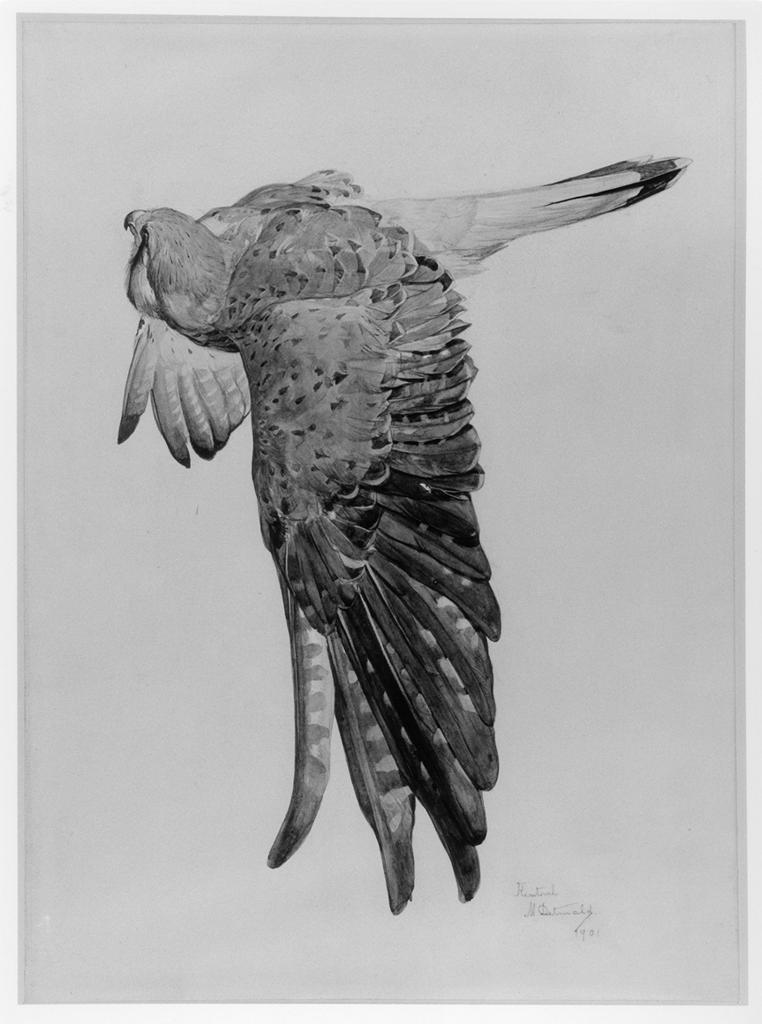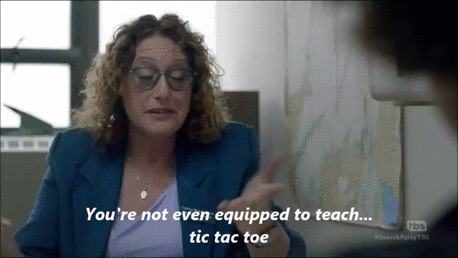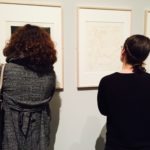
by Jean Marie Carey | 12 Jul 2018 | Animals, Animals in Art, Art History, Michelangelost©, Stuff Found in Library Books

Charles Maurice Detmold (1883-1908), Kestrel in flight, 1901. Watercolour. British Museum. Dept. of Prints and Drawings.
We, as mere humans, cannot see and feel as birds do as they navigate their habitats. Birds have immediate needs that relate directly to food availability, energy, water, and temperature, social contact, reproduction, predator detection, and shelter that are more complex than the features we perceive on their behalf as “nature.” Nevertheless, it is urgent for us to understand what bird species need from their surroundings as human intrusion, habitat loss, and climate change conspire to accelerate our need to make the best use of those habitats we can manage for the remaining populations of birds who survive. This is part of what makes Birds: The Art of Ornithology by Jonathan Elphick such a vital contribution to our historical knowledge.
A recent zoological conference in London featured a game of “Animal Studies Tic-Tac-Toe,” in which “David Attenborough” occupied a central square. Though the game was in jest, it is certainly true – and tellingly so that this is often the case even for those whose profession ostensibly involves the fauna of the wilderness – that for most people, the experience of nature is mediated by films such as those in the Life and Planet Earth series, augmented by precision editing, emotional cue music, and witty commentary.
Though not the overt intention of Birds: The Art of Ornithology, this book is a powerful reminder that connecting meaningfully with nature requires leaving the house, and that this experience is both transcendent and daunting. Birdwatching especially demands patience, silence, and solitude. Elphick conveys this foregrounding with subtlety, and describes the conditions faced by naturalists in the time before photography and video, who, tasked often only by their own passion – what John James Audubon characterized as “…nothing was left to me but my humble talents” – set out not only to observe birds but to record their activities and document their environments.
(more…)

by Jean Marie Carey | 9 Apr 2018 | Animals in Art, Art History
So, now that my time at the Rifkind Center is coming to an end, I have some breaking news announcements to post in sequence…
First, beginning this Saturday and through the summer months I will … well, be involved in a series of discussions about art history sponsored through a grant I received from the Hillsborough Public Library Cooperative. It’s all kicking off at the SouthShore Regional Public Library in Ruskin.

IKR
The SouthShore Library has a great history of funding arts programs for the patrons in its off-the-track corner of the county and I am very grateful to receive this support and for being able to work around upcoming travel obligations. The library staff had in mind a formal sequence of talks, but the proposal I made is for something more experimental that I have had in mind for a while…

…which is why I hesitate to call these “lectures.” Each session is going to be very interactive and will unfold in a participant-driven way, and there will be a digital component posted for downloading during and after each event.
(more…)

by Jean Marie Carey | 19 Jun 2017 | Art History, Re-Enactments© and MashUps
One of the paradoxes that has emerged from documenta 14 is that many of its spectacular installations make very simple statements about global consumerism using enormous material expenditures. In fact it can be difficult to see past the pyramids, windmills, and tents erected to comment on issues such as migration and the market-possessed-body – elaborate efforts to illustrate political generalities – to documenta’s truer theme, an attempt by curator Adam Szymczyk to assail, or at least supplement, canonical art history with work by indigenous and overlooked artists.

iQhiya, Monday, 2017, Performance und Installation, Ehemaliger unterirdischer Bahnhof (KulturBahnhof), Kassel, documenta 14, Foto: Fred Dott
But the contemporary art fair world floats above scholarship on a bubble of self-satisfaction. The documenta participants who are the big draws – Mona Hatoum and Pierre Huyghe for example – aren’t worried about posterity. So what was meant to be exposure becomes competition for a footnote. Some of this lesser-known work also really struggles when removed from its local context. Poor facture and inappropriate plinths meant as faux–naïf comes across as a weird form of doubled sociological good intentions gone awry, and, amid Kassel’s half-hearted Brutalist buildings, calls to mind Bernd and Hilla Becher’s photographs of Bavarians dressed as Native Americans. In this respect, perhaps it was afterall an important achievement, and more consistent with Szymczyk’s goal, to move the most of documenta to Athens.
One excellent work, shown above, is iQhiya’s Monday (2017), which unfortunately was performed only once on 13 June. Staged in Kassel’s “little” Bahnhof, the spoken, moved, video, books, saws, pens, needles cloth, and film endurance piece used an eight-hour projection loop of Sarafina! (1992) to examine the “hidden curriculum” experience of black, South African women college students. Mimicking the rhythm of a real school day, naturally people wandered in and out. The coming and goings of the Eurobahn and Regio trains moving through the station plinked the hour glass and also made a rumbling vibration that was unsettling and comforting at the same time. I’m not sure if the reference to Pascale Marthine Tayou’s Human Being @Work (2009) was intentional or ephemeral coincidence, but the eleven-member iQhiya troupe made use of sound and light in a similar way as Tayou’s (also very successful) occupation of the Biennale di Venezia’s Arsenale – only with real trains.
Now, about Olu Oguibe…
(more…)

by Jean Marie Carey | 16 May 2017 | Animals, Animals in Art, Art History, Franz Marc, German Expressionism / Modernism, Re-Enactments© and MashUps
This post goes with a book review of the exhibition catalogue Visionaries: Creating a Modern Guggenheim (2017) for Museum Bookstore which is posted here and also follows in a slightly different form below.
It has been one of life’s great pleasures to see Franz Marc’s Die gelbe Kuh many times over the years at the Solomon R. Guggenheim Museum. Every time I get the same huge surge of joy as the first, and I think other people feel the same way. When the painting is where it lives normally, in the Thannhauser wing, you can sit on a bench in the gallery and watch people come in, weaving their way through some much smaller woodcuts and decorated books, and then turn the corner to be met by this enormous colourful and cheerful painting. Always a lot of oohs and ahhs and delighted small children.
§ § §

People admiring Franz Marc’s Stallungen (1913, l) and Die gelbe Kuh (1911) at the Guggenheim.
Visionaries: Creating a Modern Guggenheim
Edited and introduced by Megan Fontanella with chapters by Vivien Greene, Jeffrey Weiss, Susan Thompson, Tracey Bashkoff, Lauren Hinkson, and Susan Davidson and published by Guggenheim Museum Publications, this catalogue accompanies the eponymous exhibition held at the Solomon R. Guggenheim Museum in New York City, 10 February-6 September 2017; 312 pages with color reproductions of all the paintings and sculptures from the exhibition plus archival photographs, illustrations, letters, and newspaper and magazine notices.
The “modernization” of European art around 1900 is usually associated with the evolution of line, color, and figuration toward abstraction, as manifested by Expressionism and Futurism. The fact that art collectors and dealers played an important role in codifying what we think of now as Modernism is brought to full light in the catalogue Visionaries: Creating a Modern Guggenheim, produced to coincide with the exhibition of the same name.
In fact the catalogue seems, at least at first glance, intent upon driving home the idea that art is a business, opening with the normally blank flyleaf emblazoned with corporate logos and an unprecedented “Sponsor Statement” by Francesca Lavazza, heir to the Lavazza coffee brand, the underwriter of the exhibition. However the scholarly contents are innovatively presented and well-researched, with five sections devoted to each of the “visionaries” (in this case being the collectors, not the artists), paired with a focus on one of the museum’s key acquisitions. An opening essay by the Guggenheim’s curator of collections and provenance, Megan Fontanella, introduces the scope of the exhibition and the historical circumstances that allowed American entrepreneur Solomon Robert Guggenheim to decide in the 1920s, after five decades dominating the U.S. mining industry, to become the world’s foremost collector and exhibitor of what became dubbed “non-objective” art. (42) As in the rest of the book, the introduction offers wisely-selected and superbly reproduced works from both the immediate exhibition and from other sources.
Of great interest are photos of the assorted collectors and dealers in domestic settings, surrounded by their objets, which are very revealing, perhaps beyond what is intended by their inclusion in a book that is an official history of the Guggenheim. It is impossible, for example, not to be vexed by the careless profligacy of Peggy Guggenheim, niece of Solomon and founder of the Guggenheim Collection Venice. She is shown on the terrace of an Île Saint-Louis flat, wearing pearls and sipping an espresso as the Nazi-occupied Paris of the 1940s falls away across the river, Constantin Brancusi’s Maiastra (1912) set perilously on the parapet beside her. (254)
In fact the catalogue is an outstanding exercise for those willing to read between its restrained lines. Taken this way, an excellent contemporized portrait of the Guggenheim’s co-founder and first director, Hilla Rebay, emerges. Fontanella and Susan Thompson dispense with the “female hysteria” characterization of Rebay as the occult-obsessed lover of painter Rudolf Bauer to focus on her acumen as a businesswoman and strategic positioning as a collage artist. Thompson shows Rebay’s collages – figurative portraits for the most part, more like mosaics made with bits of paper than Hanna Höch’s more associative and confrontational critiques of Weimar culture – as a distinct oeuvre outside the canonical avant-garde’s concentration on sculpture and painting.
Equally calculating and less sympathetic is Rebay’s outsize ambition as Guggenheim’s chief advisor and deal-maker. Fontanella reports:
Rebay […] did attend the notorious Entartete Kunst show in Munich in August 1937, fresh from the June establishment of the Solomon R. Guggenheim Foundation. The foundation would make important purchases from the ensuing German-government-sponsored degenerate art sales: [Wassily] Kandinsky’s Der blaue Berg (1908-09) and Einige Kreise (1926), and [Paul] Klee’s Tanze Du Ungeheuer zu meinem sanften Lied (1922) were among the works that entered its holdings this way in 1939 – works that might have been destroyed. (30)
…Or works that might have been returned to their rightful owners.
(more…)

by Jean Marie Carey | 7 Apr 2017 | Art History, Dogs!, Franz Marc, German Expressionism / Modernism, Re-Enactments© and MashUps
Ars Graphica is a group of mostly European scholars who study prints but also photography. The pan-European organization also has a few Gesamtstaaten. Ars Graphica Deutschland recently branched off and began its own activities. The first one was this week, a tour of the In die Dritte Dimension: Raumkonzepte auf Papier vom Bauhaus bis our Gegenwart exhibition at the Städel Museum in Frankfurt given by the curator, Jenny Glaser. You can read more about what transpired here.
Dr. Glaser has organized a really superb show. The low and direct lighting is a bit off-putting at first, but many of the works are cut-outs, collages, incisions, or have subtleties of depth that the creation of shadows augments. The El Lissitzky poster prints from the Bauhaus are the stars of the show and Glaser’s clear favorite, but the less-known miniatures (matchbox sized) by Blinky Palermo placed across from Sol LeWitt’s late (2001) colorful confetti collage are probably more interesting, as is Michael Riedel’s artist book of minute but deep surgical removals.
There was also a look at the Städel’s more traditional Renaissance and Early Modern prints, and we got to visit and share a bit about our research…of course I have a vested interest in something at the Städel that is not a print…
I thought it might be best to just tell the exciting but short story about Liegender Hund im Schnee‘s journey from the Franz Marc estate to entartete to West Palm Beach and back to the Städel. Somehow the actual Germans were able to refrain from exclaiming that “all Germans are Nazis so who really cares if the museum was looted?”*
*Actual crowd responses at two of my last talks. More on this, as I keep promising, shortly; I actually have quite a lot to say about this in reference to the College Art Association in particular and looting apologists in general.











